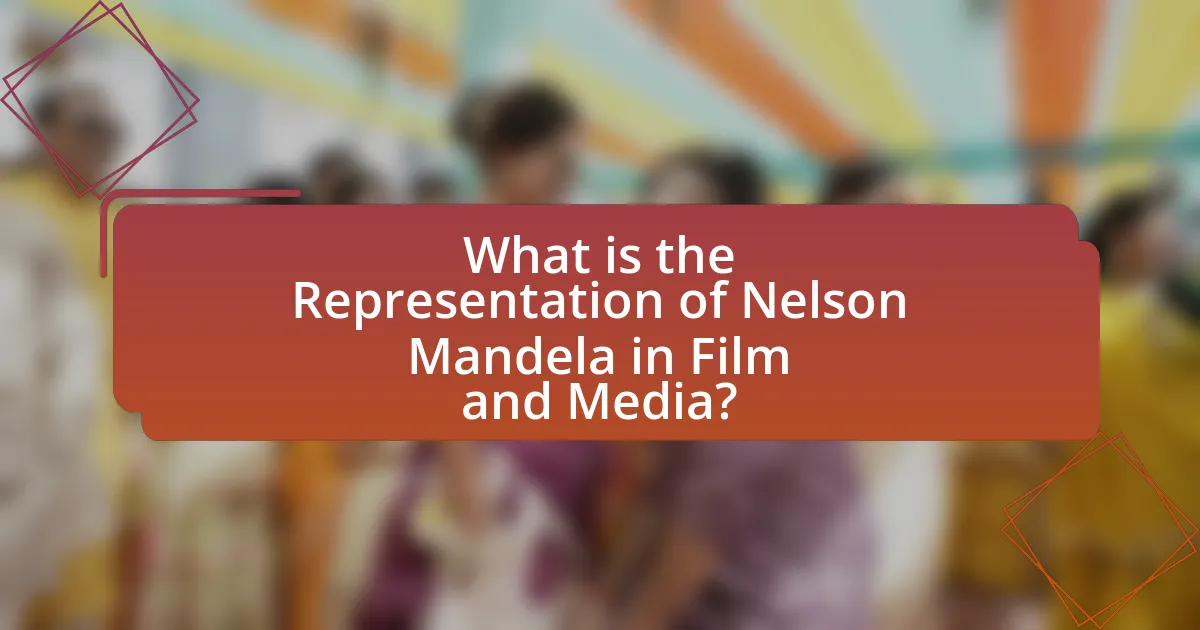The article examines the representation of Nelson Mandela in film and media, highlighting his portrayal as a symbol of resilience, justice, and reconciliation. Key films such as “Invictus,” “Mandela: Long Walk to Freedom,” and “Goodbye Bafana” illustrate significant events in Mandela’s life, including his fight against apartheid, imprisonment, and presidency. The analysis explores how these representations shape public perception, influence contemporary social movements, and reflect societal values and struggles. Additionally, it discusses the impact of historical contexts on Mandela’s legacy and the importance of responsible storytelling in media portrayals.

What is the Representation of Nelson Mandela in Film and Media?
The representation of Nelson Mandela in film and media primarily portrays him as a symbol of resilience, justice, and reconciliation. Films such as “Invictus” and “Mandela: Long Walk to Freedom” depict his struggle against apartheid, emphasizing his leadership qualities and commitment to peace. These portrayals often highlight key events in his life, such as his imprisonment and subsequent presidency, showcasing his role in uniting a divided nation. The media representation reinforces Mandela’s legacy as a global icon for human rights, evidenced by his recognition as the first black president of South Africa and his Nobel Peace Prize award in 1993.
How has Nelson Mandela been portrayed in various films?
Nelson Mandela has been portrayed in various films as a symbol of resilience, forgiveness, and leadership in the fight against apartheid. In films like “Invictus,” Mandela is depicted as a unifying figure who uses sports to bridge racial divides, showcasing his strategic thinking and ability to inspire hope among South Africans. “Mandela: Long Walk to Freedom” presents a more personal narrative, illustrating his struggles, sacrifices, and the complexities of his character, emphasizing his journey from prisoner to president. These portrayals highlight Mandela’s commitment to peace and reconciliation, reinforcing his legacy as a global icon for justice and human rights.
What are the key films that depict Nelson Mandela’s life?
The key films that depict Nelson Mandela’s life include “Mandela: Long Walk to Freedom,” “Invictus,” and “Goodbye Bafana.” “Mandela: Long Walk to Freedom,” released in 2013, is based on Mandela’s autobiography and covers his early life, imprisonment, and presidency. “Invictus,” released in 2009, focuses on Mandela’s efforts to unite South Africa through the 1995 Rugby World Cup. “Goodbye Bafana,” released in 2007, portrays Mandela’s relationship with his prison guard during his incarceration. These films collectively illustrate significant events and themes from Mandela’s life, contributing to the understanding of his legacy.
How do these films interpret Mandela’s legacy?
Films interpreting Mandela’s legacy often emphasize his role as a symbol of reconciliation and social justice. For instance, “Invictus” portrays Mandela’s efforts to unite a divided South Africa through the 1995 Rugby World Cup, showcasing his belief in forgiveness and collective identity. Additionally, “Mandela: Long Walk to Freedom” highlights his journey from prisoner to president, illustrating his commitment to fighting apartheid and advocating for equality. These films collectively reinforce Mandela’s image as a transformative leader who championed peace and human rights, supported by historical events such as his release from prison in 1990 and the subsequent democratic elections in 1994.
What role does media play in shaping public perception of Nelson Mandela?
Media plays a crucial role in shaping public perception of Nelson Mandela by framing his narrative and highlighting key aspects of his life and legacy. Through various platforms, including news articles, documentaries, and films, media has portrayed Mandela as a symbol of resistance against apartheid and a champion of peace and reconciliation. For instance, the film “Invictus” illustrates his leadership during South Africa’s transition to democracy, reinforcing his image as a unifying figure. Additionally, media coverage of his imprisonment and subsequent release emphasized his resilience and moral authority, contributing to a global perception of Mandela as an icon of justice and human rights. This consistent portrayal across different media forms has solidified Mandela’s status in public consciousness, influencing how he is remembered and celebrated worldwide.
How do documentaries contribute to the understanding of Mandela’s impact?
Documentaries contribute to the understanding of Nelson Mandela’s impact by providing a visual and narrative context that highlights his role in the anti-apartheid movement and his influence on global human rights. Through interviews, archival footage, and expert commentary, documentaries such as “Mandela: Long Walk to Freedom” and “The Last Days of Mandela” illustrate his leadership qualities, personal sacrifices, and the socio-political landscape of South Africa during his lifetime. These films present factual accounts of Mandela’s imprisonment, his negotiations to end apartheid, and his presidency, thereby reinforcing his legacy as a symbol of resilience and reconciliation. By showcasing these elements, documentaries enhance public awareness and appreciation of Mandela’s contributions to social justice and equality.
What are the differences between fictional portrayals and documentary representations?
Fictional portrayals and documentary representations differ primarily in their intent and adherence to factual accuracy. Fictional portrayals, such as dramatizations of Nelson Mandela’s life, prioritize narrative engagement and artistic interpretation, often embellishing or altering events for dramatic effect. In contrast, documentary representations aim to provide factual accounts, utilizing real footage, interviews, and historical context to present an accurate depiction of Mandela’s life and legacy. For example, the documentary “Mandela: Long Walk to Freedom” incorporates actual interviews and archival footage, emphasizing authenticity, while fictional films may take creative liberties to enhance storytelling.
Why is the representation of Nelson Mandela significant in cultural contexts?
The representation of Nelson Mandela is significant in cultural contexts because it embodies the struggle for justice, equality, and human rights. Mandela’s life story, from his anti-apartheid activism to his presidency, serves as a powerful symbol of resilience and reconciliation, influencing global movements for social change. His portrayal in film and media, such as in “Invictus” and “Mandela: Long Walk to Freedom,” highlights his impact on both South African society and the international community, reinforcing the values of forgiveness and unity. This representation not only educates audiences about historical injustices but also inspires ongoing dialogues about race, identity, and activism in contemporary culture.
How does Mandela’s representation reflect societal values and struggles?
Mandela’s representation reflects societal values and struggles by embodying the fight against apartheid and the pursuit of equality and justice. His portrayal in film and media often highlights themes of resilience, forgiveness, and the importance of collective action, which resonate with the broader societal aspirations for human rights and dignity. For instance, the film “Invictus” illustrates Mandela’s efforts to unite a divided nation through the 1995 Rugby World Cup, symbolizing hope and reconciliation in post-apartheid South Africa. This representation aligns with the global struggle for social justice, showcasing Mandela as a universal symbol of resistance against oppression and a champion for peace.
What impact does Mandela’s portrayal have on contemporary social movements?
Mandela’s portrayal significantly influences contemporary social movements by serving as a symbol of resilience and justice. His depiction in various films and media highlights themes of equality, forgiveness, and the struggle against oppression, which resonate with current movements advocating for social justice, such as Black Lives Matter and climate activism. For instance, the film “Mandela: Long Walk to Freedom” emphasizes his commitment to non-violence and reconciliation, inspiring activists to adopt similar approaches in their own struggles. This representation reinforces the idea that systemic change is achievable through perseverance and moral integrity, thus motivating new generations to engage in activism.
How do different cultures interpret Nelson Mandela’s representation?
Different cultures interpret Nelson Mandela’s representation through various lenses shaped by historical, social, and political contexts. For instance, in South Africa, Mandela is predominantly viewed as a national hero and a symbol of reconciliation, reflecting the country’s struggle against apartheid and his role in fostering unity post-1994. In contrast, Western cultures often emphasize his global advocacy for human rights and social justice, portraying him as an icon of peace and moral leadership.
In African nations, Mandela’s legacy is frequently associated with pan-Africanism and liberation, highlighting his influence on anti-colonial movements across the continent. Conversely, in some Asian cultures, Mandela is recognized for his resilience and determination, serving as an inspiration for social movements against oppression. These interpretations are supported by various media portrayals, such as the film “Invictus,” which illustrates his leadership style and ability to unite diverse groups, reinforcing the multifaceted nature of his representation across cultures.
What variations exist in Mandela’s portrayal across different countries?
Nelson Mandela’s portrayal varies significantly across different countries, reflecting diverse cultural, political, and historical contexts. In South Africa, Mandela is predominantly depicted as a national hero and symbol of reconciliation, emphasizing his role in ending apartheid and fostering unity. Conversely, in Western nations, such as the United States and the United Kingdom, he is often celebrated for his leadership and moral courage, with a focus on his struggle against oppression and advocacy for human rights. In contrast, some countries with strained relations with the West may present Mandela in a more critical light, highlighting his associations with armed resistance and anti-colonial sentiments. For instance, in parts of the Middle East, Mandela’s legacy is sometimes framed within the context of anti-imperialism, portraying him as a figure of resistance against Western dominance. These variations illustrate how Mandela’s image is shaped by local narratives and geopolitical dynamics, influencing public perception and cultural representation.
How do cultural backgrounds influence the interpretation of Mandela’s actions?
Cultural backgrounds significantly influence the interpretation of Nelson Mandela’s actions by shaping the values, beliefs, and historical contexts through which individuals view his legacy. For instance, in South Africa, Mandela is often celebrated as a national hero who fought against apartheid, embodying resilience and reconciliation. Conversely, in Western contexts, his actions may be interpreted through a lens of political strategy and diplomacy, emphasizing his role in global human rights advocacy. This divergence is evident in various media portrayals, where South African narratives focus on his personal sacrifices and the struggle for freedom, while international representations may highlight his leadership qualities and the broader implications of his work. Such interpretations are further influenced by cultural narratives surrounding colonialism, race relations, and social justice, which vary widely across different societies.
What are the common themes found in international representations of Mandela?
Common themes found in international representations of Nelson Mandela include resilience, forgiveness, leadership, and the struggle for justice. Resilience is often depicted through Mandela’s unwavering commitment to fighting apartheid despite facing imprisonment for 27 years. Forgiveness is highlighted in his post-release efforts to promote reconciliation in South Africa, exemplified by his support for the Truth and Reconciliation Commission. Leadership is portrayed through his role as a unifying figure who inspired both national and global movements for equality. The struggle for justice is a recurring theme, emphasizing Mandela’s dedication to human rights and social justice, which resonates in various films and documentaries that chronicle his life and legacy. These themes collectively illustrate Mandela’s impact on global human rights discourse and his enduring symbol of hope and change.
How do historical contexts affect the representation of Nelson Mandela?
Historical contexts significantly shape the representation of Nelson Mandela by influencing the narratives and themes portrayed in various media. For instance, during the anti-apartheid movement, Mandela was often depicted as a revolutionary hero fighting against systemic oppression, reflecting the global sentiment against apartheid in the 1980s. Conversely, after his release in 1990 and subsequent election as South Africa’s first Black president in 1994, representations shifted to emphasize reconciliation and nation-building, aligning with the historical context of post-apartheid South Africa. This evolution in portrayal is evident in films like “Invictus,” which highlights his role in uniting a divided nation through sports, showcasing how historical events dictate the lens through which Mandela’s legacy is viewed.
What historical events shape the narratives surrounding Mandela in film and media?
The historical events that shape the narratives surrounding Nelson Mandela in film and media include his imprisonment, the anti-apartheid movement, and his presidency. Mandela was imprisoned for 27 years, from 1962 to 1990, which became a focal point in global discussions about human rights and justice. His release in 1990 marked a significant turning point in South Africa’s history, symbolizing hope and reconciliation. The anti-apartheid movement, which gained international support, highlighted Mandela’s role as a leader and martyr for freedom, influencing various films and documentaries that depict his struggle and resilience. Additionally, Mandela’s presidency from 1994 to 1999, during which he worked to dismantle apartheid and promote national unity, further solidified his legacy, providing rich material for filmmakers to explore themes of forgiveness and leadership. These events collectively contribute to the complex narratives surrounding Mandela in film and media, illustrating his impact on both South Africa and the world.
How do these historical contexts alter the perception of Mandela’s legacy?
Historical contexts significantly alter the perception of Mandela’s legacy by framing his actions and ideals within the socio-political landscape of apartheid and post-apartheid South Africa. For instance, during apartheid, Mandela was viewed as a terrorist by the South African government and some international entities, while he was celebrated as a freedom fighter by anti-apartheid activists. This dichotomy influences how different groups interpret his legacy; for example, his imprisonment is often seen as a symbol of resistance against oppression, while his later presidency is viewed through the lens of nation-building and reconciliation efforts. Additionally, the portrayal of Mandela in films and media often emphasizes these historical contexts, shaping public perception by highlighting his struggles and achievements in relation to the broader narrative of racial equality and justice.
What are the implications of Nelson Mandela’s representation in film and media?
Nelson Mandela’s representation in film and media significantly shapes public perception and understanding of his legacy and the broader struggle against apartheid. This portrayal often emphasizes themes of resilience, forgiveness, and leadership, which can inspire social justice movements globally. For instance, films like “Invictus” and “Mandela: Long Walk to Freedom” highlight his role in uniting a divided nation, reinforcing the narrative of reconciliation over revenge. Such representations can influence how audiences perceive historical events and figures, potentially fostering a simplified or romanticized view of complex realities. Additionally, the media’s framing of Mandela can affect contemporary political discourse, as his image is frequently invoked in discussions about equality and human rights, thereby sustaining his relevance in ongoing social issues.
How does Mandela’s representation influence youth and future generations?
Mandela’s representation significantly influences youth and future generations by embodying ideals of resilience, justice, and equality. His portrayal in various films and media highlights his struggle against apartheid and his commitment to reconciliation, inspiring young people to advocate for social change. For instance, the film “Invictus” illustrates Mandela’s leadership in uniting a divided nation through sport, demonstrating the power of forgiveness and collaboration. This representation serves as a powerful educational tool, encouraging youth to engage in activism and promoting values of empathy and understanding in their communities.
What lessons can be learned from Mandela’s portrayal in media?
Mandela’s portrayal in media teaches the importance of narrative framing in shaping public perception. Media representations often highlight his resilience and moral leadership, emphasizing themes of forgiveness and reconciliation, which can inspire social change. For instance, films like “Invictus” depict Mandela’s strategic use of sports to unite a divided nation, illustrating how media can amplify messages of hope and unity. This portrayal underscores the power of storytelling in influencing societal values and promoting empathy, as seen in the global response to his life and legacy.
How can filmmakers responsibly depict historical figures like Mandela?
Filmmakers can responsibly depict historical figures like Nelson Mandela by prioritizing accuracy, context, and respect for their legacy. Accurate representation involves thorough research into Mandela’s life, including his political activism, personal struggles, and achievements, ensuring that the portrayal reflects the complexities of his character and the historical context of his actions. Contextual accuracy is crucial; filmmakers should depict the socio-political environment of apartheid South Africa to provide viewers with a comprehensive understanding of Mandela’s significance. Respect for Mandela’s legacy entails honoring his values of reconciliation and justice, avoiding sensationalism or oversimplification of his story. For instance, the film “Mandela: Long Walk to Freedom” is based on Mandela’s autobiography, which helps ensure a more authentic representation of his life and ideals.
What are the best practices for analyzing representations of historical figures?
The best practices for analyzing representations of historical figures include contextualizing their portrayal within the socio-political environment of their time, examining the sources and mediums of representation, and critically assessing the narrative techniques employed. Contextualization allows for a deeper understanding of how historical events and cultural attitudes shape the depiction of figures like Nelson Mandela. For instance, analyzing films and media representations of Mandela requires an exploration of apartheid’s impact on South Africa and how that context influences storytelling choices. Evaluating sources involves scrutinizing the credibility and perspective of the creators, as biases can significantly affect representation. Lastly, assessing narrative techniques, such as character development and visual symbolism, reveals how these elements contribute to the audience’s perception of the historical figure. These practices ensure a comprehensive and nuanced analysis of representations, leading to a more informed understanding of their significance in cultural discourse.
How can audiences critically engage with portrayals of Nelson Mandela?
Audiences can critically engage with portrayals of Nelson Mandela by analyzing the accuracy and context of the representations in film and media. This involves examining the historical events depicted, such as Mandela’s role in the anti-apartheid movement, and assessing how these portrayals align with documented facts, such as his imprisonment from 1962 to 1990 and his subsequent presidency from 1994 to 1999. Additionally, audiences should consider the perspectives and biases of the filmmakers, as well as the cultural and political implications of the narratives presented. For instance, films like “Invictus” and “Mandela: Long Walk to Freedom” offer different interpretations of Mandela’s legacy, prompting viewers to reflect on the complexities of his character and the socio-political landscape of South Africa. Engaging with critiques and analyses from historians and cultural commentators can further enhance understanding and foster a more nuanced appreciation of Mandela’s impact on global human rights.
What resources are available for further exploration of Mandela’s representation?
Resources available for further exploration of Mandela’s representation include academic journals, documentaries, and biographies. Notable academic journals such as “African Studies Review” and “Journal of Southern African Studies” often publish articles analyzing Mandela’s portrayal in various media. Documentaries like “Mandela: Long Walk to Freedom” and “The Last Days of Mandela” provide visual insights into his life and legacy. Additionally, biographies such as “Long Walk to Freedom” by Nelson Mandela himself and “Mandela: The Authorized Biography” by Anthony Sampson offer in-depth perspectives on his representation and impact. These resources collectively contribute to a comprehensive understanding of Mandela’s cultural representation.




